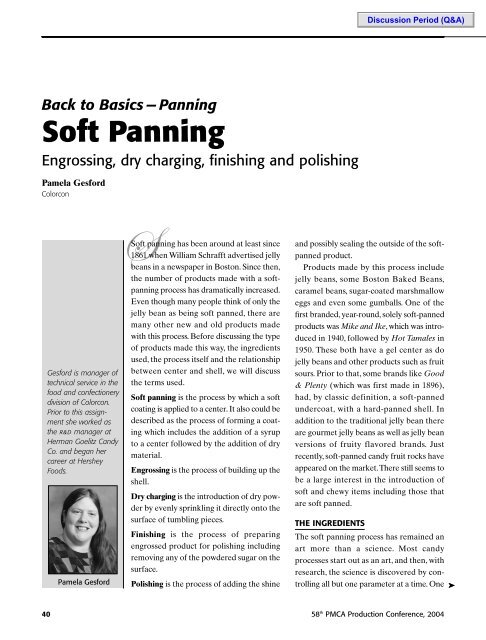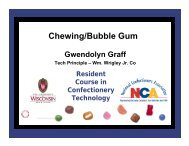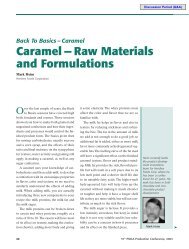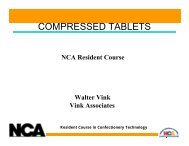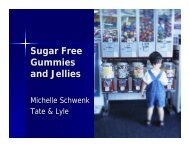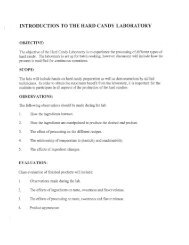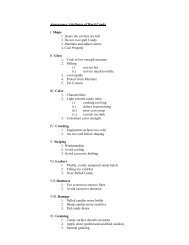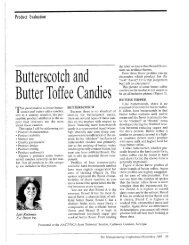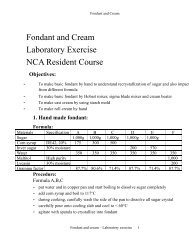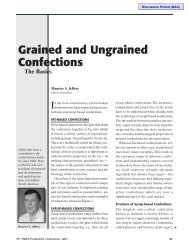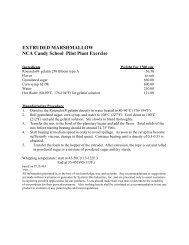2004 Soft Panning - staging.files.cms.plus.com
2004 Soft Panning - staging.files.cms.plus.com
2004 Soft Panning - staging.files.cms.plus.com
You also want an ePaper? Increase the reach of your titles
YUMPU automatically turns print PDFs into web optimized ePapers that Google loves.
Back to Basics — <strong>Panning</strong><br />
<strong>Soft</strong> <strong>Panning</strong><br />
Engrossing, dry charging, finishing and polishing<br />
Pamela Gesford<br />
Colorcon<br />
Gesford is manager of<br />
technical service in the<br />
food and confectionery<br />
division of Colorcon.<br />
Prior to this assignment<br />
she worked as<br />
the r&d manager at<br />
Herman Goelitz Candy<br />
Co. and began her<br />
career at Hershey<br />
Foods.<br />
Pamela Gesford<br />
f<br />
<strong>Soft</strong> panning has been around at least since<br />
1861 when William Schrafft advertised jelly<br />
beans in a newspaper in Boston. Since then,<br />
the number of products made with a softpanning<br />
process has dramatically increased.<br />
Even though many people think of only the<br />
jelly bean as being soft panned, there are<br />
many other new and old products made<br />
with this process. Before discussing the type<br />
of products made this way, the ingredients<br />
used, the process itself and the relationship<br />
between center and shell, we will discuss<br />
the terms used.<br />
<strong>Soft</strong> panning is the process by which a soft<br />
coating is applied to a center. It also could be<br />
described as the process of forming a coating<br />
which includes the addition of a syrup<br />
to a center followed by the addition of dry<br />
material.<br />
Engrossing is the process of building up the<br />
shell.<br />
Dry charging is the introduction of dry powder<br />
by evenly sprinkling it directly onto the<br />
surface of tumbling pieces.<br />
Finishing is the process of preparing<br />
engrossed product for polishing including<br />
removing any of the powdered sugar on the<br />
surface.<br />
Polishing is the process of adding the shine<br />
and possibly sealing the outside of the softpanned<br />
product.<br />
Products made by this process include<br />
jelly beans, some Boston Baked Beans,<br />
caramel beans, sugar-coated marshmallow<br />
eggs and even some gumballs. One of the<br />
first branded, year-round, solely soft-panned<br />
products was Mike and Ike, which was introduced<br />
in 1940, followed by Hot Tamales in<br />
1950. These both have a gel center as do<br />
jelly beans and other products such as fruit<br />
sours. Prior to that, some brands like Good<br />
& Plenty (which was first made in 1896),<br />
had, by classic definition, a soft-panned<br />
undercoat, with a hard-panned shell. In<br />
addition to the traditional jelly bean there<br />
are gourmet jelly beans as well as jelly bean<br />
versions of fruity flavored brands. Just<br />
recently, soft-panned candy fruit rocks have<br />
appeared on the market.There still seems to<br />
be a large interest in the introduction of<br />
soft and chewy items including those that<br />
are soft panned.<br />
THE INGREDIENTS<br />
The soft panning process has remained an<br />
art more than a science. Most candy<br />
processes start out as an art, and then, with<br />
research, the science is discovered by controlling<br />
all but one parameter at a time. One ➤<br />
40 58 th PMCA Production Conference, <strong>2004</strong>
factor that seems to deter the thorough<br />
evaluation of the scientific aspects of soft<br />
panning is the <strong>com</strong>plexity of the variables<br />
that influence this process. Ingredient<br />
choices have a large influence on the finished<br />
product, including the center, syrup<br />
ingredients, drying powder material and<br />
minor or optional ingredients.The majority<br />
of soft-panned products are sucrose<br />
based, so that will be the focus of this<br />
paper. However, sugafree and dextrosebased<br />
products are also popular.<br />
The Center<br />
The center is <strong>com</strong>monly the largest portion<br />
of any soft-panned product. The center<br />
can be from 50 to 70 percent of the finished<br />
piece by weight. Gel centers are the<br />
most <strong>com</strong>mon. However, they are not all<br />
the same.The formulation and production<br />
of gel centers could make a paper in and of<br />
itself but there are a few <strong>com</strong>ments that<br />
need to be made since the characteristics<br />
of any center influence the soft-panned<br />
product greatly. Centers may contain<br />
starch, gelatin, pectin or even a <strong>com</strong>bination.<br />
Some of the newer modified starches<br />
or gums may also make an acceptable center<br />
for soft-panned products if the resulting<br />
gel is robust enough to hold up to the<br />
tumbling action and the weight from a fully<br />
loaded pan.<br />
Some of the most important attributes<br />
for centers are related to uniformity. Size,<br />
shape and moisture uniformity are all<br />
important for any center. For gel centers,<br />
uniform size and shape are directly related<br />
to the quality of depositing. Size and shape<br />
uniformity allow an equal coating to be<br />
achieved on the majority of pieces in the<br />
pan since surface area is important to the<br />
amount of syrup and dry ingredients that<br />
are required. Mogul maintenance, frequent<br />
board weights and even sifting to remove<br />
depositing defects can help keep centers<br />
uniform. Starch-deposited centers with flat<br />
tops can even have sunken backs if<br />
improperly dried, creating a great surface<br />
for the engrossing syrup to glue two pieces<br />
together. For sugar-sanded centers, using<br />
a uniform size of sugar like bakers special<br />
sugar can be a good starting surface on<br />
which to base a soft-panned shell.Also, for<br />
a gel center, be aware that issues in cooking<br />
or depositing can cause centers that<br />
are softer and more easily deformed, even<br />
though they are at the proper moisture<br />
level. For instance, gelatin base that is held<br />
for an extended period at a high temperature,<br />
especially in the presence of acid, will<br />
degrade, resulting in softer, less rigid centers.Also,<br />
high methoxyl pectin can pregel<br />
if held too long after acid addition and<br />
then can easily tear during further processing.<br />
Even starch, if not properly<br />
hydrated or cooked, can create a weaker<br />
center. Any of these changes in center<br />
quality can greatly impact the ability to<br />
soft pan the centers as well as the stability<br />
of any finished product.<br />
Other centers can present challenges of<br />
their own. Having a nut center presents a<br />
challenge due to adherence of the shell to<br />
the center as well as possible water absorption.<br />
Most choose to subcoat these centers.<br />
Subcoating ingredients will be discussed<br />
later along with optional ingredients. Uniform-sized<br />
nut centers can be selected for<br />
soft-panned products.Any other center for<br />
soft panning may have similar challenges<br />
but may also have other unique attributes<br />
that need to be controlled to produce a<br />
stable, uniform end product.<br />
Engrossing Syrup<br />
The <strong>com</strong>position of the engrossing syrup<br />
varies depending on the texture desired. For<br />
normal sugar-based products, the syrup is<br />
normally a noncrystallizing syrup made up<br />
of sugar, corn syrup and water. For syrup,<br />
bulk granulated sugar is normally used. Different<br />
corn syrups can be used, for example, ➤<br />
<strong>Soft</strong> <strong>Panning</strong><br />
One factor that<br />
seems to deter the<br />
thorough<br />
evaluation of the<br />
scientific aspects of<br />
soft panning is the<br />
<strong>com</strong>plexity of the<br />
variables that<br />
influence this<br />
process.<br />
58 th PMCA Production Conference, <strong>2004</strong> 41
<strong>Soft</strong> <strong>Panning</strong><br />
The larger the grain<br />
of the sugar, the<br />
more the candy<br />
pieces are reliant<br />
on the tumbling<br />
action of the pan to<br />
produce a durable<br />
smooth coating.<br />
42 or 62 de. Most manufacturers seem to<br />
formulate with the type of corn syrup that<br />
they typically have on hand. Syrup preparation<br />
usually involves bringing the water<br />
and sugar to a boil to dissolve the sugar<br />
and then adding the corn syrup.<br />
The <strong>com</strong>position of the syrup has a<br />
direct influence on the finished texture of<br />
the bean. The ratio of sucrose to corn<br />
syrup (on a solids basis) strongly affects<br />
the textural attributes of the finished product.A<br />
ratio of 1 part sucrose to 0.5 parts of<br />
corn syrup (on a solids basis) produces a<br />
harder texture as opposed to a 1 to 1 ratio,<br />
which produces a soft texture. Sometimes<br />
thinned corn syrup can be used to make an<br />
even softer product. Some traditional<br />
materials suggest that solids of most syrups<br />
used should be 70 to 72 percent. However,<br />
more practically, higher solids closer to<br />
the 74 to 78 percent range are used. As<br />
with any cooked syrup, sugar inversion<br />
can play a role in possible defects. Since<br />
most syrups used in soft panning are noncrystallizing,<br />
the creation of invert sugar is<br />
less likely to slow production as in hard<br />
panning but it may cause other faults like<br />
instability of products in storage. Factors<br />
that influence the rate of sugar inversion<br />
are the ash level of the sugar, the cooking<br />
and holding time at high temperatures and<br />
the presence of acid.<br />
Dry Powder<br />
The next major ingredient is the dry powder<br />
that is added to the shell. Normally,<br />
two to three sizes of sugar are used for dry<br />
charging.The order that the sugar is added<br />
is from the largest to the smallest size. Particle<br />
size and particle size distribution are<br />
two of the most important factors for the<br />
dry charge material. Extra fine granular,<br />
bakers special sugar, 6X confectioners<br />
sugar and 10X confectioners sugar can be<br />
used.The larger the grain of the sugar, the<br />
more the candy pieces are reliant on the<br />
tumbling action of the pan to produce a<br />
durable smooth coating.<br />
Optional Raw Materials<br />
Minor and optional raw materials used in<br />
soft panning are those ingredients that are<br />
used in smaller amounts but can be critical<br />
to making the variety of products that are<br />
seen in the market today. Colors, flavors,<br />
waxes, center subcoat ingredients, confectioners<br />
glaze, acids and other flavoring/<br />
decorating ingredients are those ingredients<br />
that warrant being mentioned. Colors<br />
can be either dye or pigment based.<br />
Traditionally, FD&C dye-based colors were<br />
used in jelly beans but now many products<br />
are made with FD&C aluminum lakes as<br />
well as colors from natural sources. The<br />
use of pigments like FD&C aluminum<br />
lakes, titanium dioxide or carmine can hide<br />
some crystallization faults in soft-panned<br />
coatings. FD&C dyes and most other colors<br />
from natural sources usually produce a<br />
more transparent appearance. Colors are<br />
typically added to the engrossing syrup.<br />
Flavors, on the other hand, can be added<br />
to a subcoat, in the engrossing syrup or<br />
even directly onto the pieces during the<br />
engrossing process. Mostly liquid flavors<br />
are used. Water-soluble powders can also<br />
be used but they may not be as cost effective.The<br />
carrier of liquid flavors may influence<br />
the panning process. Oils may interfere<br />
with tumbling and cause pieces to slide<br />
in the pan. Large amounts of propylene<br />
glycol or glycerin (<strong>com</strong>mon carriers for<br />
liquid flavors) may interfere with stability<br />
by holding moisture in the shell until<br />
stressed, causing sticky surfaces in packaged<br />
products.Alcohol-based flavors evaporate<br />
quickly, sometimes flashing off top<br />
notes as well.<br />
Depending on the desired flavor, various<br />
acids can be used in soft-panned items.<br />
Buffered lactic acid solution, malic,<br />
fumaric, tartaric or citric acid can be added ➤<br />
42 58 th PMCA Production Conference, <strong>2004</strong>
to the engrossing syrup, keeping in mind<br />
the effect low pH has on the rate of sugar<br />
inversion. Powdered acid can be mixed<br />
with sugar and dry charged directly onto<br />
the product. Care needs to be taken to<br />
avoid dry charging with crystalline dry<br />
acids so as not to cause pitting on the inside<br />
surface of the pan.<br />
Subcoat ingredients are typically used<br />
with centers that are sensitive to moisture.<br />
Perfect examples are peanuts or other nutmeats<br />
that would be subject to an increase<br />
in oxidative rancidity if exposed to the<br />
moisture from engrossing syrup. Subcoat<br />
ingredients can be gum arabic, maltodextrin/tapioca<br />
dextrin, gelatin, modified<br />
starches or a <strong>com</strong>bination of these.<br />
Inclusions like colored sugar or other<br />
small particulates can be added in the last<br />
engrossing steps to provide an interesting<br />
appearance. Color dispersions or other colored<br />
films can be added as speckles or<br />
spots on the surface as well. Polishing will<br />
be discussed in another paper but the<br />
ingredients that are used in these steps also<br />
can be included in minor and optional<br />
ingredients. Waxes, typically carnauba<br />
and/or beeswax, are used on soft-panned<br />
products to impart a shine, whereas confectioners<br />
glaze can be used as a sealant<br />
over the wax polish to maintain the shine<br />
and protect the product over time. Pigmented<br />
confectioners glazes can be used as<br />
an optional ingredient to speckle finished<br />
polished products. Some of the latest versions<br />
of these products are even made with<br />
newly available pearlescent pigments. Edible<br />
ink can be printed onto various softpanned<br />
products to denote brand name,<br />
for seasonal decoration or possibly to<br />
denote flavor or variety.<br />
There are many variations of ingredients<br />
that allow a growing variety of softpanned<br />
products (Figure 1).<br />
Sugarfree and Dextrose<br />
Before discussing the soft-panning process<br />
itself, a few <strong>com</strong>ments need to be made<br />
regarding the differences in ingredients<br />
when sugarfree or dextrose panning is<br />
desired. In sugarfree it is most logical to<br />
substitute a noncrystallizing syrup for the<br />
traditional engrossing syrup, followed by<br />
fine uniform crystalline sugar substitutes.<br />
Sugar substitutes may not be available in<br />
varying particle sizes so only one size of<br />
uniform distribution should be used.<br />
Remember, a high-intensity sweetener may<br />
need to be added to the engrossing syrup<br />
if the <strong>com</strong>bined relative sweetness of the<br />
ingredients used is significantly lower than<br />
sugar. Despite the differences in ingredients,<br />
the examination of the cross section<br />
of a sugarfree gourmet jelly bean shows<br />
the structure of the shell to be similar to<br />
any gourmet jelly bean. Most suppliers of<br />
sugarfree ingredients can give you suggestions<br />
for the specific use of their products<br />
in panning. Before choosing sugarfree<br />
ingredients, hydroscopicity, ease of use,<br />
performance, possible laxation effect, label<br />
acceptability and cost are all major factors<br />
to be considered.<br />
When using dextrose to make softpanned<br />
products, it seems the major differences<br />
are the makeup of the engrossing<br />
syrup and the use of dextrose as the<br />
dry charge sugar. A different engrossing<br />
syrup <strong>com</strong>position is needed to avoid crystallization<br />
faults in the soft coating. This<br />
major contributing factor is due to the dextrose<br />
level of the corn syrup used. Suggestions<br />
included the addition of either highfructose<br />
(may be slightly sticky to work<br />
with) or high-maltose corn syrup to avoid<br />
this problem.Whether using sucrose, dextrose<br />
or many sugarfree substitutes, the<br />
process is the same.<br />
THE PROCESS<br />
Now that the ingredients have been reviewed<br />
the process should be discussed next (Fig-<br />
<strong>Soft</strong> <strong>Panning</strong><br />
In sugarfree it is<br />
most logical to<br />
substitute a<br />
noncrystallizing<br />
syrup for the<br />
traditional<br />
engrossing syrup,<br />
followed by fine<br />
uniform crystalline<br />
sugar substitutes.<br />
Decorative Ingredients<br />
for <strong>Soft</strong>-panned<br />
Products<br />
Pearlescent Pigmented<br />
Confectioners Glaze<br />
Figure 1<br />
Edible Ink<br />
Vanilla Bean Seeds<br />
58 th PMCA Production Conference, <strong>2004</strong> 43<br />
➤
<strong>Soft</strong> <strong>Panning</strong><br />
<strong>Soft</strong> panning is<br />
probably the most<br />
challenging<br />
panning process to<br />
move into the<br />
larger automated<br />
pans.<br />
Sugar on Jelly Beans<br />
Dry sugar on surface of<br />
in-process jelly bean<br />
After 5 minutes of run<br />
time, sugar has worked<br />
into surface of in-process<br />
jelly bean<br />
Figure 3<br />
ure 2). Suggested room conditions for soft<br />
panning are temperatures between 60º to<br />
70ºF and relative humidity below 55 percent.<br />
Normally, rotary pans from 36 to 42 inches in<br />
diameter are used for most soft-panned products.These<br />
can be round or tulip shaped and<br />
they are normally stainless steel. However,<br />
for nonacid products, copper pans can be<br />
used. Pans can be ribbed or roughened with<br />
a <strong>com</strong>bination of syrup and sugar prior to<br />
running to assist in tumbling.<br />
<strong>Soft</strong> panning is probably the most challenging<br />
panning process to move into the<br />
larger automated pans. The first reason<br />
that this is such a challenge is due to the<br />
normally tender/soft nature of the typical<br />
center and the fact that some of these<br />
larger pans can have fairly deep bed<br />
depths. In conventional pans, pan speeds<br />
from 20 to 22 rpm seem to be the most<br />
<strong>com</strong>monly used. Since the idea is to attach<br />
the dry charge material with the engrossing<br />
syrup and not to dry and crystallize<br />
the engrossing syrup, drying air is not normally<br />
used. Prepared engrossing syrup is<br />
applied to tumbling centers and allowed<br />
to distribute evenly over the pieces. The<br />
idea is to add a dose of engrossing syrup<br />
that is big enough to wet the entire surface<br />
of the center without gluing the centers<br />
together. The scoops of dry material are<br />
added and allowed to pack onto the surface.<br />
As the tumbling action continues,<br />
the syrup begins to surround the dry powder<br />
and what is typically referred to as<br />
sweatback occurs. This means the surface<br />
appears once again to be moist. More of<br />
the dry charge material is added gradually<br />
until it does not sweat back. Sometimes<br />
it may seem that the end point has<br />
been reached but if the product is allowed<br />
to tumble a little longer the sugar can<br />
work into the surface (Figure 3).<br />
Many factors contribute to the timing of<br />
the dry powder addition and that is the second<br />
challenge for the large, more continu-<br />
ous pans when making soft-panned items.<br />
The <strong>com</strong>bination of one application of syrup<br />
followed by the scoops of dry charge material<br />
needed to dry the surface make up one<br />
layer. Next, another charge of engrossing<br />
syrup is added followed by scoops of dry<br />
material in a similar fashion to the first wetting.<br />
Generally, two to four layers are added<br />
but depending on the thickness of the<br />
desired coat, there can be up to 10 layers<br />
added. Normally, the finer particle size of<br />
dry material is added in the last layer or<br />
layers. This finer material can pack in<br />
between the larger particles and form a<br />
smoother exterior, which will allow for a<br />
more easily polished surface.The last layer<br />
is usually powdered sugar. Product should<br />
be removed to trays to stand overnight to<br />
allow excess moisture to be released to the<br />
air or at least to equilibrate with the center.<br />
If an insufficient amount of powdered<br />
sugar is added to the pieces and sweatback<br />
occurs after the pieces are trayed then the<br />
pieces will have a tendency to stick together<br />
and the coating can even peel off when separated.<br />
After standing overnight the product<br />
is ready for finishing and polishing, a<br />
topic covered by another paper.<br />
<strong>Soft</strong> panning is a process that seems to<br />
be simple and should be easy. However, it<br />
is difficult to do well. One might consider<br />
this a “Goldilocks” process. One porridge<br />
<strong>Soft</strong> <strong>Panning</strong> Process<br />
Figure 2<br />
Prepared Centers<br />
Prepared Syrup Drying Sugar<br />
Engrossing<br />
Process<br />
Finishing and<br />
Polishing<br />
44 58 th PMCA Production Conference, <strong>2004</strong><br />
➤
is too hot, another is too cold and the last<br />
is just right. In this way, dilemmas arise in<br />
soft panning unless certain attributes are<br />
just right. For example, if the dose of<br />
engrossing syrup is too high, it can lead to<br />
doubles and clumping. If the dose is too<br />
low, the distribution will be uneven across<br />
the pieces and lead to uneven coating.<br />
If pan loading is too low the centers will<br />
not tumble correctly, which will interfere<br />
with proper coating. If it is too high the<br />
centers may crush (if soft) or pieces will<br />
be<strong>com</strong>e flying projectiles after the shell<br />
starts to build.<br />
Product can stick together and form<br />
doubles if the engrossing syrup solids are<br />
too high, if the centers are improperly subcoated,<br />
if too much syrup is added at once,<br />
if the centers are too soft, if the pan speed<br />
is too slow or if the dry charge sugar is<br />
added too late.<br />
Malformed shapes or uneven surface<br />
coating can be from too much sugar at the<br />
beginning of the process, if the application<br />
of syrup is too small to evenly distribute, if<br />
the sugar granulation is too small (or too<br />
many fines) or if the centers are nonuniform.<br />
Finished soft-panned products normally<br />
have 10 to 17 percent moisture in<br />
the shell but this does depend on the panning<br />
technique as well as any migration of<br />
moisture between center and shell.<br />
An Experiment with Variations<br />
Since jelly beans are still used as the main<br />
example of soft panning, an experiment to<br />
produce various jelly beans with variations<br />
in engrossing syrup <strong>com</strong>position as well as<br />
the type of sugar used for dry charging was<br />
conducted.With the exception of the largeproduction-pan<br />
run done for video purposes,<br />
all samples were made in a small 15inch<br />
lab pan (which for soft panning is not<br />
optimal since the tumbling action is instrumental<br />
to forming the coating). For <strong>com</strong>parison<br />
purposes, a typical formula was<br />
done in the small pan as well as the production<br />
size. These formulations were<br />
made with four layers that had similar<br />
amounts of engrossing syrup and the<br />
amount of dry sugar required to dry each<br />
layer (Figure 4).This means that the resulting<br />
products may have different weight<br />
gains resulting in differing center to shell<br />
ratios. In Run 6, the one made with only<br />
sucrose in the engrossing syrup, the amount<br />
of that syrup had to be increased slightly<br />
just to wet the pieces properly. In Run 4,<br />
made with the larger seasonal jelly bean<br />
center, the amount of syrup seemed to<br />
make the pieces overly wet so there were<br />
a larger number of doubles formed. All<br />
jelly beans were placed in trays overnight<br />
and then polished. A 65° Brix finishing<br />
syrup was applied to wet the powdered sugar<br />
on the surface.When dry, this was followed<br />
by an application of wax (beeswax and carnauba)<br />
in alcohol and glazed with a shellacbased<br />
confectioners glaze.<br />
Various evaluations were done on the<br />
six jelly bean runs.The results can be seen<br />
in Figure 5. Center and shell percentages<br />
were calculated in two ways. First, all the<br />
ingredients used were put into a formula<br />
by weight and then the percentage of center<br />
was calculated (denoted as calculated).<br />
This method does not take into account<br />
any loss of ingredients to the pan or surrounding<br />
air.The second method is based<br />
on the weighing of a number of finished<br />
beans and subtracting the original weight<br />
of the same number of centers. This<br />
method is denoted as measured in the data<br />
table. Finished jelly beans from each run<br />
were taken apart and water activities and<br />
moistures were taken on both the shell and<br />
center for each. During the production<br />
batch, samples were also taken periodically<br />
for similar evaluation (Figure 4).The<br />
trends of changes in moisture do not seem<br />
as apparent as expected; piece-to-piece<br />
variation may be to blame. Moistures were<br />
➤<br />
<strong>Soft</strong> <strong>Panning</strong><br />
If the dose of<br />
engrossing syrup is<br />
too high, it can<br />
lead to doubles and<br />
clumping; if the<br />
dose is too low, the<br />
distribution will be<br />
uneven and lead to<br />
uneven coating.<br />
58 th PMCA Production Conference, <strong>2004</strong> 45
<strong>Soft</strong> <strong>Panning</strong><br />
Finished soft-panned<br />
products normally<br />
have 10 to 17 percent<br />
moisture in the shell.<br />
done by an outside laboratory with a losson-drying<br />
technique that is done slowly so<br />
as not to experience case hardening on the<br />
gel centers.The products made in the small<br />
pan had much higher moistures than the<br />
production run. The moistures found in<br />
the production run were much more typical<br />
with 10 to 17 percent finished-product<br />
moisture levels and were essentially the<br />
same between center and shell. Water<br />
activities were done with a benchtop water<br />
activity measurement device. Only the production<br />
sample, Run 1, had a higher water<br />
activity in the center than the shell.<br />
In examining the resulting jelly beans<br />
from the above experiment, there are a<br />
few observations that need to be pointed<br />
out. Run 1, the production run, looked the<br />
Production Run/Run # 4th Wetting 4th Wetting Glazed and<br />
Before Powdered After Powdered Stored in Trays<br />
2nd Wetting 3rd Production Run Sampling<br />
Moisture and Water Activity Results<br />
Wetting Sugar Addition Sugar Addition Wax Only Glazed Overnight<br />
% Moisture shell 15.9 15.5 14.6 14.2 11.7 13.7 15.4<br />
% Moisture center 15.2 15.4 18.5 14.7 13.3 12.5 15.8<br />
Water activity (shell) 0.623 0.686 0.672 0.683 0.581 0.590 0.477<br />
Water activity (center)<br />
Figure 4<br />
0.595 0.696 0.598 0.629 0.580 0.553 0.508<br />
Production Run Evaluations<br />
Run 1 Run 2 Run 3 Run 4 Run 5 Run 6<br />
Pan Size Production size Lab size Lab size Lab size Lab size Lab size<br />
Syrup Type Combined corn Combined corn Combined corn Combined corn Thinned corn Sugar syrup<br />
syrup and sugar syrup and sugar syrup and sugar syrup and sugar syrup<br />
Gel Center Type Small gourmet Small gourmet Small gourmet Large seasonal Small gourmet Small gourmet<br />
Dry Charge Sugar Bakers special Bakers special Extra fine granular, Bakers special Bakers special Bakers special<br />
Center and Shell Relationship<br />
and powdered and powdered bakers special<br />
and powdered<br />
and powdered and powdered and powdered<br />
Center % (measured) 52.1% 66.4% 69.5% 67.6% 63.3% 63.3%<br />
Shell % (measured) 47.9% 33.6% 30.5% 32.4% 36.7% 36.7%<br />
Center % (calculated) 52.0% 65.4% 64.7% 65.3% 61.2% 62.1%<br />
Shell % (calculated)<br />
Syrup Formulation<br />
48.0% 34.6% 35.3% 34.7% 38.8% 37.9%<br />
Sugar to corn syrup solids ratio 0.9:1 0.9:1 0.9:1 0.9:1 0:1 0:1<br />
Water % 19% 19% 19% 19% 13.4% 27%<br />
Sucrose % 33% 33% 33% 33% 0% 73%<br />
42 de corn syrup % 48% 48% 48% 48% 86.6% 0%<br />
Solids—°Brix<br />
Formulation<br />
74.9° 74.2° 73.0° 72.5° 70.7° 73°<br />
Center % 52.0% 65.4% 64.7% 65.3% 61.2% 62.1%<br />
Syrup % 7.4% 8.5% 8.4% 8.5% 7.9% 10.2%<br />
Red color dispersion % 0.5% 0.6% 0.6% 0.6% 0.6% 0.7%<br />
Berry flavor % 0.3% 0.3% 0.3% 0.3% 0.3% 0.3%<br />
Citric acid % 0.3% 0.1% 0.1% 0.1% 0.1% 0.1%<br />
Extra fine granular sugar 0% 0% 18.0% 0% 0% 0%<br />
Bakers special sugar 34.1% 19.4% 5.7% 22.6% 28.3% 19.3%<br />
Powdered sugar 5.5% 5.7% 2.1% 2.5% 1.6% 7.2%<br />
Total sugar dry charge 39.6% 25.1% 25.8% 25.1% 29.9% 26.5%<br />
Moisture and Water Activity Results<br />
% Moisture shell 15.4% 22.0% 20.6% 25.1% 26.4% 21.4%<br />
% Moisture center 15.8% 24.6% 22.7% 24.5% 24.5% 24.9%<br />
Water activity (shell) 0.477 0.498 0.460 0.511 0.489 0.512<br />
Water activity (center)<br />
Figure 5<br />
0.508 0.482 0.441 0.494 0.454 0.494<br />
46 58 th PMCA Production Conference, <strong>2004</strong><br />
➤
est followed by Run 5, which was made<br />
with engrossing syrup <strong>com</strong>prised of<br />
thinned corn syrup (Figure 6). However,<br />
maybe this is not surprising if the total percentage<br />
of dry charge is reviewed. Run 5<br />
has a total dry charge percentage closer to<br />
that of Run 1 and more than the other variants<br />
made in the small lab pan (Figure 5).<br />
As expected, the shell of Run 6, which had<br />
the sugar-only engrossing syrup, became<br />
opaque, crystallized and crunchy. It was<br />
almost impossible to polish, possibly due to<br />
a rough surface or the tendency to make<br />
dust that transfers back to the polish layer<br />
from the pan surface. Obviously, this is why<br />
even when desiring a harder shell, some<br />
corn syrup still needs to be included in the<br />
engrossing syrup. The large seasonal-type<br />
jelly bean center made a decent finished<br />
product (Run 4) but the texture seemed<br />
slightly grainy. It is difficult to say which<br />
of the jelly bean variants would make a<br />
more acceptable, stable product if done in<br />
a large production pan.<br />
In conclusion, a few other <strong>com</strong>ments<br />
need to be made. The above process portion<br />
of this paper makes soft panning seem<br />
so simplistic and straightforward. As previously<br />
mentioned, knowing when to add<br />
more powder and when to add the next<br />
syrup is key to an acceptable and stable<br />
finished product. Patience may be a virtue<br />
but in the process of soft panning it has to<br />
be an essential part of the standard operating<br />
procedure. If the formulation and<br />
process are developed wisely, quality softpanned<br />
products can be consistently produced.<br />
There are seemingly endless <strong>com</strong>binations<br />
of flavor, appearance and texture<br />
that can be <strong>com</strong>bined in soft-panned products<br />
to catch the eye and please the palate<br />
of consumers. ■<br />
<strong>Soft</strong>-panned Products —Cross Sections<br />
Figure 6<br />
Whole jelly bean from Run 1<br />
Whole jelly bean from Run 2<br />
Whole jelly bean from Run 3<br />
Jelly bean 2 cross section<br />
Jelly bean 3 cross section<br />
Whole jelly bean from Run 4 Jelly bean 4 cross section<br />
Whole jelly bean from Run 5 Jelly bean 5 cross section<br />
Whole jelly bean from Run 6<br />
Jelly bean 1 cross section<br />
Jelly bean 6 cross section<br />
<strong>Soft</strong> <strong>Panning</strong><br />
58 th PMCA Production Conference, <strong>2004</strong> 47


